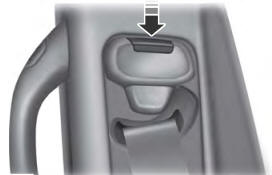Ford Explorer: Roof Opening Panel / Removal and Installation - Roof Opening Panel Frame
Ford Explorer 2020-2025 Service Manual / Body and Paint / Body and Paint / Roof Opening Panel / Removal and Installation - Roof Opening Panel Frame
Removal
NOTE: Removal steps in this procedure may contain installation details.
-
If replacing the roof opening panel frame, remove the air deflector.
Refer to: Air Deflector (501-17 Roof Opening Panel, Removal and Installation).
-
Remove the roof opening glass.
Refer to: Roof Opening Panel Glass (501-17 Roof Opening Panel, Removal and Installation).
-
Remove the headliner.
Refer to: Headliner (501-05 Interior Trim and Ornamentation, Removal and Installation).
-
Disconnect the drain hoses.
.jpg) |
-
Disconnect the electrical connector.
.jpg) |
-
With the help of assistant.
Remove the bolts and lower the roof opening panel frame.
Torque: 97 lb.in (11 Nm)
.jpg) |
-
With the help of assistant.
Remove the roof opening panel frame out the rear of the vehicle.
.jpg) |
Installation
-
To install, reverse the removal procedure.
-
Transfer parts as necessary.
 Removal and Installation - Roof Opening Panel Fixed Glass
Removal and Installation - Roof Opening Panel Fixed Glass
Removal
NOTE:
Removal steps in this procedure may contain installation details.
Remove the roof opening panel frame.
Refer to: Roof Opening Panel Frame (501-17 Roof Opening Panel, Remov..
 Removal and Installation - Roof Opening Panel Glass
Removal and Installation - Roof Opening Panel Glass
Removal
NOTE:
Removal steps in this procedure may contain installation details.
NOTE:
This procedure is for the sliding glass panel only.
Open the roof opening panel shield...
Other information:
Ford Explorer 2020-2025 Service Manual: Removal and Installation - Generator Current Sensor
Removal NOTE: Removal steps in this procedure may contain installation details. Disconnect the battery/batteries. Refer to: Battery Disconnect and Connect (414-01 Battery, Mounting and Cables, General Procedures). Release the tabs and remove the BJB cover...
Ford Explorer 2020-2025 Service Manual: Removal and Installation - Second Row Single Seat Cushion Cover - Vehicles With: Second Row Captain Chairs
Special Tool(s) / General Equipment Interior Trim Remover Removal NOTE: LH (left hand) seat shown, RH (right hand) seat similar. Remove the second row seat. Refer to: Second Row Seat - Vehicles With: Second Row Captain Chairs (501-10B Second Row Seats, Removal and Installation)...
Categories
- Manuals Home
- 6th Generation Explorer Owners Manual
- 6th Generation Explorer Service Manual
- Body and Paint
- Interior Trim and Ornamentation
- Description and Operation - Identification Codes
- New on site
- Most important about car
Seatbelt Height Adjustment
WARNING: Position the seatbelt height adjuster so that the seatbelt rests across the middle of your shoulder. Failure to adjust the seatbelt correctly could reduce its effectiveness and increase the risk of injury in a crash.

Copyright © 2025 www.foexplorer.com
